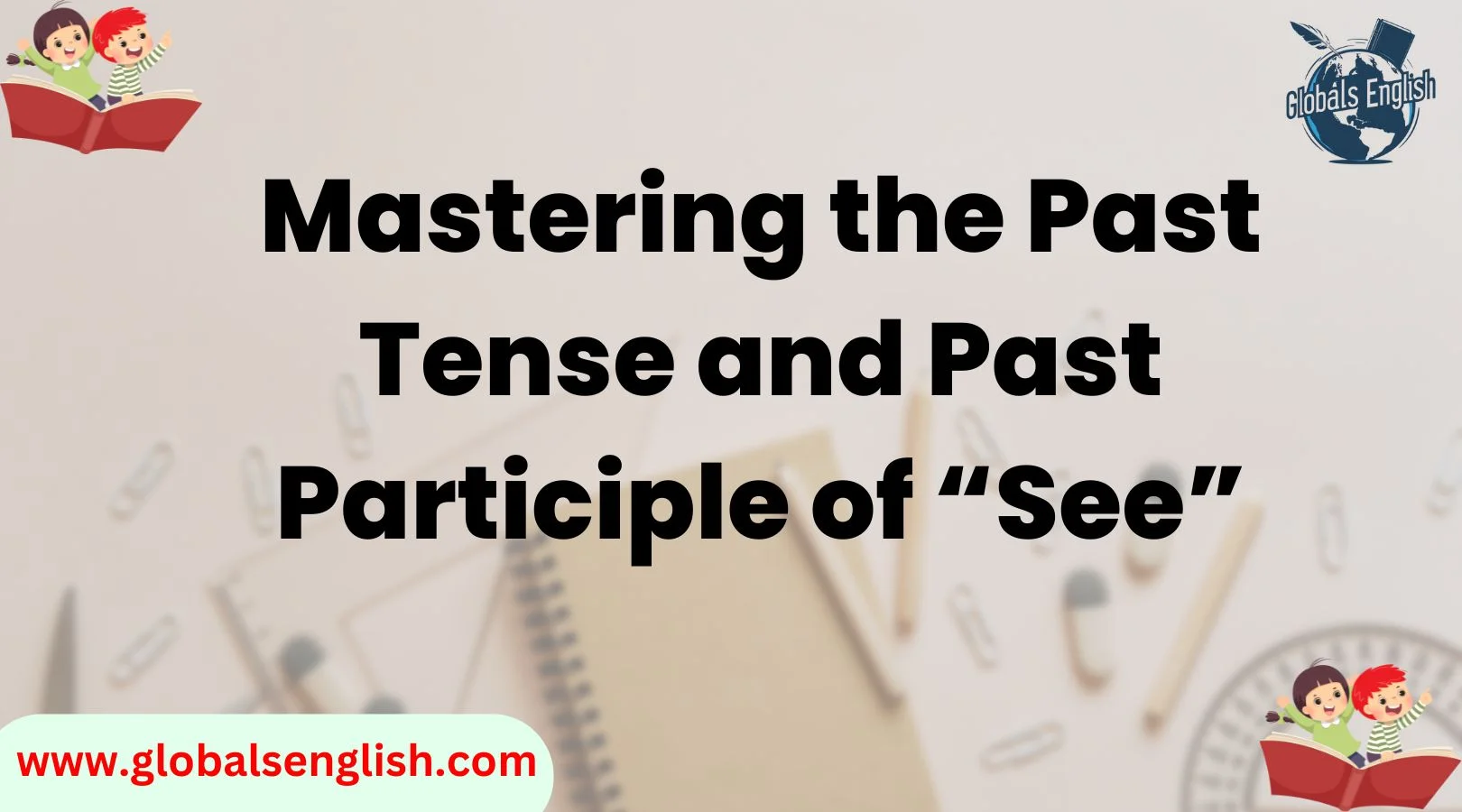If you’ve ever wondered why we say “I saw” and “I have seen” but never “I seen,” you’re not alone. The past tense and past participle of the verb “see” confuse many English learners and even native speakers.
But don’t worry, you’re not alone in the struggle, and in this post, we’re going to break it down for you.
By the end of this article, you’ll have a clear understanding of when to use “saw” and “seen,” and you’ll be able to apply these rules confidently in your speech and writing. From casual conversations to academic essays, mastering this grammar point will help elevate your communication skills.
This topic isn’t just a simple grammar issue—it’s a common hurdle many face in their journey to improve their English proficiency.
Whether you’re learning English as a second language or refining your native grammar, getting this right is essential. So, let’s dive into the correct uses of the past tense and past participle of “see”!
Understanding the Verb “See”
Before we dive into the past tense and past participle, it’s important to understand exactly what kind of verb we’re working with. “See” is an irregular verb, meaning it doesn’t follow the typical rule of adding “-ed” to form the past tense or past participle (like “walk” becoming “walked”).
What Kind of Verb Is “See”?
The verb “see” is irregular, which means it has unique forms for its past tense and past participle. Irregular verbs are tricky because they don’t follow the predictable patterns we might expect.
Let’s compare “see” to a regular verb like “play.” You can easily guess the past tense of “play” is “played,” but “see” doesn’t work that way!
Understanding irregular verbs like “see” is crucial for speaking and writing correctly. Irregular verbs are common in everyday language, so mastering them will significantly improve your language skills.
Base Form, Past Tense, and Past Participle – The Quick Chart
Let’s start with a quick visual breakdown of the verb “see” in its different forms:
| Base Form | Past Tense | Past Participle |
| see | saw | seen |
Base Form: “See” – the verb in its most basic form (used in the present tense).- Past Tense: “Saw” – used to describe an action completed in the past.
- Past Participle: “Seen” – used with auxiliary verbs like “have” or “had” to indicate a completed action.
The Past Tense of “See” — When and How to Use “Saw”
When to Use the Simple Past
The simple past tense is used when describing actions that were completed at a specific point in the past. With the verb “see,” we use “saw” to show that the action happened in the past.
For example:
- “I saw a movie last night.”
- “She saw the sunset while walking on the beach.”
The key here is that these actions happened at a specific time and are finished. So, whenever you’re talking about something that occurred in the past and is now over, “saw” is your go-to choice.
Examples of “Saw” in a Sentence
Here are some examples of “saw” in different contexts to help illustrate how the past tense of “see” works:
- Casual Conversation: “I saw you at the mall yesterday, but you didn’t see me.”
- Formal Writing: “The researcher saw a significant shift in the data over the course of the study.”
- Storytelling: “He saw a strange figure lurking in the shadows.”
Notice how “saw” is used when talking about something that happened at a specific point in the past.
The Past Participle of “See” — Understanding “Seen”
Now that we’ve covered the past tense “saw,” let’s move on to the past participle form of “see.” This is where things can get a little tricky because “seen” doesn’t stand alone; it’s always paired with an auxiliary verb like “have,” “has,” or “had.”
What Is a Past Participle Anyway?
A past participle is a verb form that’s typically used in perfect tenses. It describes actions that are completed but may still have relevance to the present, past, or future. For example:
- Present perfect: “I have seen that movie.”
- Past perfect: “She had seen the show before it was canceled.”
In these cases, the verb “seen” works with helping verbs to indicate a completed action.
When to Use “Seen”
You’ll always use “seen” with an auxiliary verb, never on its own. Here are the three main perfect tenses where you’ll use “seen”:
- Present Perfect: Describes an action that happened at an unspecified time before now.
- Example: “I have seen that movie several times.”
- Example: “I have seen that movie several times.”
- Past Perfect: Describes an action that happened before another action in the past.
- Example: “By the time I arrived, she had seen the movie.”
- Example: “By the time I arrived, she had seen the movie.”
- Future Perfect: Describes an action that will be completed before another future action.
- Example: “By next year, I will have seen all the films in the series.”
- Example: “By next year, I will have seen all the films in the series.”
Common Sentence Structures Using “Seen”
To use “seen” correctly, you’ll need an auxiliary verb. Here are a few examples:
- Present Perfect: “They have seen the new exhibit at the museum.”
- Past Perfect: “We had seen the play before it closed.”
- Future Perfect: “By next summer, I will have seen all the historical sites.”
“Saw” vs. “Seen”: Clearing Up the Confusion
Why People Mix These Up
One of the biggest mistakes people make with “see” is confusing “saw” and “seen”. This happens for a couple of reasons. First, people often use “seen” in casual conversation instead of “saw” because it sounds natural in some dialects or informal speech. Second, many English learners confuse the past tense and past participle forms because they look somewhat similar.
For example, you might hear:
- “I seen the movie last week.” This is incorrect.
- “I saw the movie last week.” This is correct.
Quick Test: Can You Spot the Error?
Now it’s time for a quick test! Can you find the error in the following sentences?
- “She has seen that film many times.”
- “I saw her at the party last night.”
- “They have saw the new exhibit at the museum.”
Take a moment, and when you’re ready, check the answers:
- #1 is correct (present perfect).
- #2 is correct (simple past).
- #3 should be “have seen.”
Using “See,” “Saw,” and “Seen” in Everyday Speech and Writing
Conversation Examples
In everyday speech, people often use “see,” “saw,” and “seen” without thinking too much about grammar. But to sound more fluent and natural, it’s essential to use these verbs correctly.
For instance:
- “I saw him at the café yesterday, but I didn’t talk to him.”
- “Have you seen the new movie yet?”
- “She sees her friends every weekend.”
These examples show how the base form, past tense, and past participle of “see” work in natural conversation.
Writing Examples
In writing, the rules become a little more structured, but the principle remains the same:
- Formal: “The teacher saw a noticeable improvement in the student’s work.”
- Informal: “I saw your message, and I’ll get back to you soon.”
When writing, make sure your tense matches the time frame you’re discussing. Don’t mix “saw” with “seen” unless you’re using an auxiliary verb.
Advanced Grammar Insights: Verb Tense Matching and Parallelism
Using “Seen” in Perfect Tenses
As we mentioned earlier, “seen” is used with auxiliary verbs. This is often in the perfect tenses, which describe actions that have been completed. Let’s look at these tenses in more detail:
- Present Perfect: “I have seen the show before.”
- Past Perfect: “By the time I arrived, she had seen the movie.”
- Future Perfect: “By the time you finish, I will have seen it.”
When using perfect tenses, always ensure that the action you’re describing is complete or relevant to the current context.
Matching Tenses in Complex Sentences
One of the trickiest parts of English grammar is making sure your verb tenses match in complex sentences. For instance:
- “When she saw me, I had seen her earlier that day.”
Here, the past perfect (“had seen”) indicates that the action happened before the action in the past tense (“saw”).
Common Errors with “See,” “Saw,” and “Seen”
Grammar Mistakes to Avoid
Let’s revisit some common mistakes people make with these forms:
- Incorrect: “I seen the movie yesterday.” (Wrong! The correct form is “I saw the movie yesterday.”)
- Incorrect: “She have seen that film.” (Wrong! The correct form is “She has seen that film.”)
Regional and Dialectal Variations
In some regions, especially in Southern American English, people might say “I seen” instead of “I saw.” While this is common in certain dialects, it’s important to understand that standard grammar uses “saw” in the past tense and “seen” in the perfect tenses.
Helpful Memory Tricks to Remember the Correct Forms
Mnemonics That Actually Work
One easy trick to remember the difference between “saw” and “seen” is this:
- “I saw with my own eyes.”
- “I’ve seen things others haven’t.”
This simple rhyme helps remind you that “saw” is the past tense, while “seen” is used in the perfect tenses.
Visualization and Patterning
Another way to remember is by visualizing a simple timeline:
- “Saw” = something that happened at a specific time.
- “Seen” = something that has been completed in relation to another action or moment.
Teaching Tip: How to Help Others Master These Forms
Great for ESL or Young Learners
Teaching the difference between “saw” and “seen” can be tricky, especially for ESL learners. Here are a few strategies:
- Use real-life examples to make the difference clear.
- Provide plenty of opportunities for practice, such as fill-in-the-blank exercises.
Practice Exercises
For younger students or learners, create interactive worksheets where they have to choose between “saw” and “seen” in different sentences. This can help reinforce the concept in a hands-on way.
Conclusion
Mastering the past tense and past participle of “see” is an essential skill for anyone learning English, from beginners to advanced speakers. By understanding when to use “saw” and “seen,” you’ll speak and write more clearly, and you’ll avoid some of the most common mistakes in English grammar.
Remember: “saw” is used for actions that happened in the past, and “seen” requires a helping verb. Once you practice, this distinction will become second nature.
Happy learning, and don’t forget: practice makes perfect!
FAQs: Past Tense and Past Participle of “See”
1. What is the past tense of “see”?
The past tense of “see” is “saw.” You use it when talking about something that happened at a specific point in the past.
✅ Example: “I saw a shooting star last night.”
2. What is the past participle of “see”?
The past participle of “see” is “seen.” It must always be used with a helping verb such as have, has, or had.
✅ Example: “I have seen that movie before.”
3. Can I say “I seen it” in a sentence?
❌ No, “I seen it” is grammatically incorrect.
✅ Correct form: “I saw it” or “I have seen it.”
Remember: “seen” needs a helping verb like have or had to be correct.
4. Is “seen” ever used without “have,” “has,” or “had”?
❌ No. “Seen” is a past participle and cannot be used alone. It must be paired with a helping verb.
✅ Example: “She has seen that show.”
5. What’s the difference between “saw” and “seen”?
- “Saw” is the simple past tense, used alone.
✅ Example: “We saw a rainbow.” - “Seen” is the past participle, used with have/has/had.
✅ Example: “We have seen that rainbow before.”

As the visionary founder and CEO of Globals English, Emma Brooke is dedicated to transforming the way individuals learn and master the English language.
